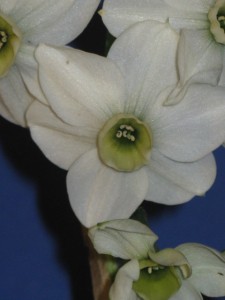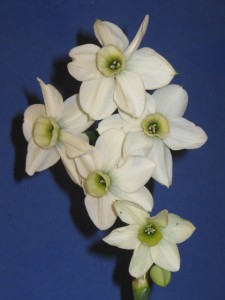Hi Daffnetters,
Thanks to Bob Spotts for more information on the Viridiflorus seedlings .
This is the first season I have flowered Emerald Sea and a couple of other Viridiflorus sdlgs.
In Otaki here,we are still very early season; still winter rather than spring, but we are in an area that seldom has heavy frosts or prolonged periods of frosts John Hunter is in Nelson , hopefully the locals there will not be offended if I say that they can have far heavier and more frequent frosty spells in June and July when Emerald Sea and similar would be flowering. We are probably talking frosts of – 5 c to – 7 c in Nelson, although it also is very regularly near the top of the sunshine hours in N Z. John assures me that they handle Nelson winters without any flower or leaf damage – – they just stand still and hardly open in the frosty spells. Erlicheer , grown in the open , does not do well for John and is not a commercial crop in Nelson
but is grown for cutflowers by many in my area. I hope you can compare conditions to your Northern gardens.
When I recieved the Virid sdlgs from John , about 7 – 8 weeks ago , the daffseek species pages had just come on line and I was very keen to check it out as I have not seen the species. I was interested in the natural habitat of Viridiflorus species as it is usually a good indication of its preferred growing conditions .
It took considerable Google searching to find that it was in North Africa , the Pyranees and, surprisingly a colony thriving on the rock of Gibraltar. It may be worth the Species Committee considering adding to the very good Species Pages where they are found in the wild.
We have many members who have wandered the remote valleys over most of Europe ,giving us good reports on many species habitats. Have any seen Viridiflorus in the wild — if so , where , when , time , altitude ,etc . I’m sure many would be interested.
Last week I showed this John Hunter seedling on the plant . Wilf gave me the more mature stem to look for pollen
J A H — 62 – – 98 B Grand Monarque — x — Emerald Sea
A look into the youngest 2 flowers , checking for pollen ..Viridiflorus is a grandparent ..
Cheers John ..




Here in Upstate South Carolina where we had a prolonged (and what seemed to be an exceptionally cold!) winter this past year, including a number of nights in the teens, lots of heavy frosts and even some snowfall and ice, my Koopowitz seedlings (‘Emerald Sea’ open pollinated) fared reasonably well. Foliage emerged in mid-November and didn’t die back until early- to mid-June. Admittedly, when the bulbs were in flower in December and January, I did offer protection, but only for the flowers’ sake. The bulbs and foliage, otherwise, had no protection from the elements. In 2008, I first planted the bulbs in one location where they performed poorly. In 2009, I opted for a spot with better drainage, and the seedlings showed a sigificant improvement.
I realize the winters of South Carolina can’t even be compared to the higher elevations in North Carolina (just thirty minutes away!) much less any place else, but these have been my experiences with the few Narcissus viridiflorus descendants I’ve grown. I’m told that N. viridiflorus is strictly a greenhouse bulb. After all, the average garden simply cannot mimic its natural habitat, but it is good to know that N. viridiflorus progency and their progency can tolerate a wider range of conditions.
Greg Freeman
Walhalla, South Carolina, USA
http://www.SouthernEdition.com